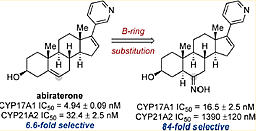Abiraterone Analog for Prostate Cancer with Reduced Side Effects
TECHNOLOGY NUMBER: 2019-198

OVERVIEW
An analog to abiraterone which creates fewer off-target interactions- Interacts differently with the target responsible for abiraterone toxicity
- Widens the therapeutic window for treatment of all androgen dependent tumors
BACKGROUND
Prostate cancer remains the second most lethal cancer in U.S. males. Prostate cancer cells are often dependent on androgens, such as testosterone, for their growth and proliferation. Androgens bind to and activate androgen receptors on prostate cancer cells, stimulating their growth. Therefore, therapies that target androgen signaling pathways, such as androgen deprivation therapy (ADT) or medications like abiraterone, which inhibit androgen production, can be effective in treating prostate cancer by depriving the cancer cells of the hormones they need to grow. Abiraterone works by inhibiting the enzyme CYP17A1, which is involved in the production of androgens. However, the use of this therapeutic risks causing side effects including hypertension, hypokalemia, and edema. As such, a need exists for an improved form of abiraterone for treatment of prostate cancer patients.
TECHNOLOGY
Researchers have created an analog to abiraterone which creates fewer off-target interactions. Specifically this agent interacts differently with CYP21A2, which is the target thought to be the cause of increased hypertension and additional side effects seen with abiraterone treatment. This abiraterone analog contains a B-ring substitution which makes it more selective for treating prostate cancer. Inhibition studies reveal that this new analog has an 80-fold increase in selective targeting of CYP17A1 for inhibition compared to CYP21A2, creating a candidate agent with greater potency and fewer side effects. The widened therapeutic window created by this analog may also be used for treatment of other neoplasms that are influenced by concentrations of androgens, such as breast cancer.
PATENT APPLICATION
Number: US9611270B2